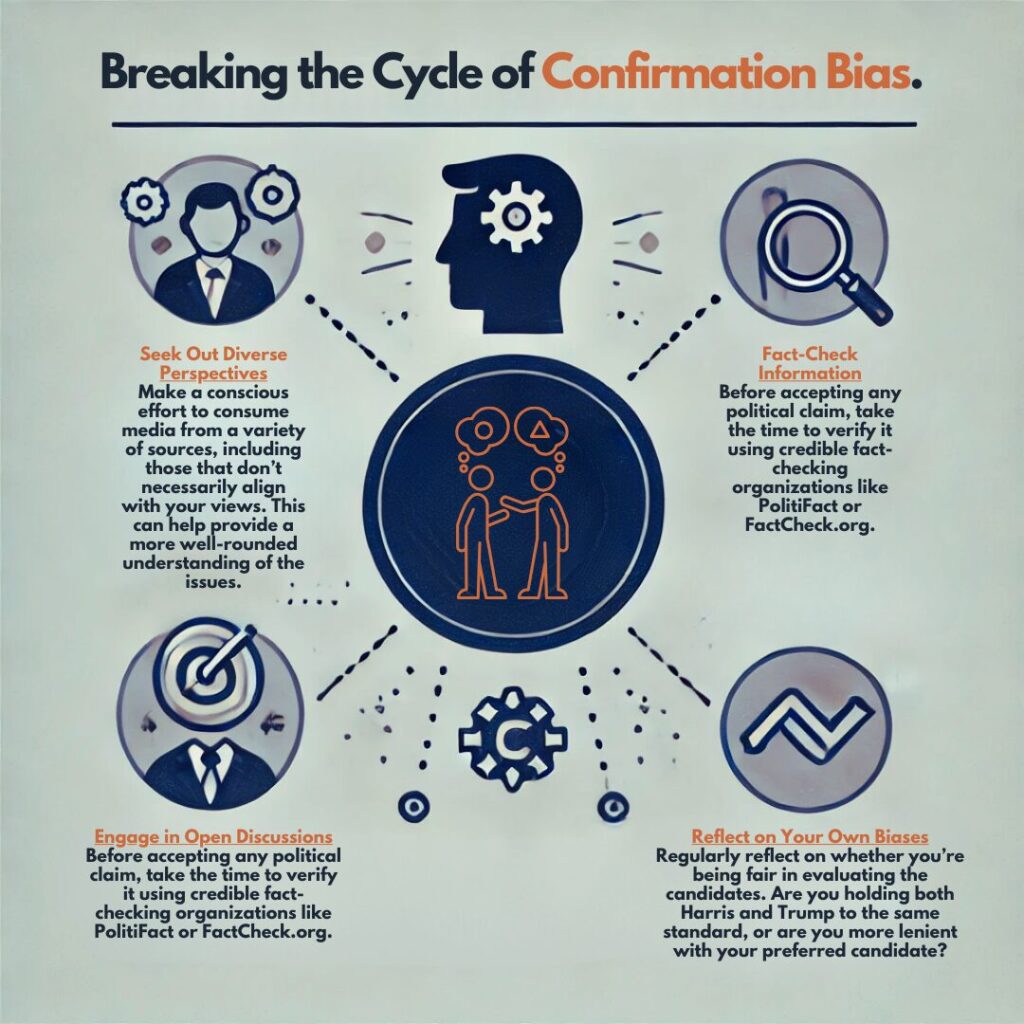
As the 2024 U.S. Presidential Election draws closer, confirmation bias is playing an increasingly prominent role in how voters perceive candidates. With Vice President Kamala Harris as the Democratic nominee and former President Donald Trump representing the Republicans, voters on both sides are doubling down on their beliefs, selectively seeking out information that supports their views while ignoring anything that contradicts them. This has made it more challenging to have open discussions about each candidate’s strengths and weaknesses, further dividing the electorate.
Understanding Confirmation Bias
Confirmation bias is the psychological phenomenon where individuals favor information that supports their pre-existing beliefs, while ignoring or dismissing contradictory evidence. This cognitive bias is particularly evident in politics, where emotions run high and ideological lines are often rigid. During an election cycle, confirmation bias can shape how voters consume media, interact with social networks, and even process facts.
As a result, meaningful conversations about the qualifications, policies, and leadership capabilities of candidates become less about objective evaluation and more about reinforcing existing loyalties.
In an election cycle, confirmation bias manifests in several ways: voters consume media that aligns with their views, echo their preferred candidate’s talking points, and dismiss the opposition’s criticisms as baseless or irrelevant. As a result, meaningful conversations about policy, leadership, and the future of the country become harder to engage in, and the political divide grows wider.
The 2024 Presidential Race: A Case Study in Confirmation Bias
With Kamala Harris and Donald Trump as the main contenders for the presidency, confirmation bias is playing out in striking ways. Supporters of each candidate are quick to praise their preferred nominee while dismissing valid concerns raised by the opposing side.
Kamala Harris: Defending a New Face for the Democrats
Kamala Harris, as the Democratic nominee, presents a new chapter in the party’s leadership. Her supporters often emphasize her historic candidacy—potentially the first female president and the first woman of color in the Oval Office—as key reasons to back her. They point to her experience as Vice President, her legal background as a prosecutor, and her progressive stance on issues such as climate change, healthcare, and social justice as evidence of her qualifications.
However, Harris has also faced criticism, particularly concerning her past as California’s Attorney General, where some say her record on criminal justice reform was not as progressive as it is now. Her tenure as Vice President has also been scrutinized, with critics arguing that she has lacked visibility or effectiveness on certain national issues. These criticisms are often dismissed by her supporters as either exaggerated or irrelevant, viewing any negative press as politically motivated attacks by conservative media.
Donald Trump: The Outsider Returns
Former President Donald Trump continues to command fierce loyalty from his supporters, who view him as an outsider determined to shake up Washington politics. His “America First” policies, tough stance on immigration, and economic successes during his first term are points of pride for his base. Despite the controversies surrounding Trump—ranging from his involvement in the January 6th Capitol riot to multiple legal battles, including charges related to classified documents—many of his supporters view these issues as nothing more than attempts by the political establishment to take him down.
For Trump’s loyalists, these legal issues are seen not as disqualifying, but as proof that he remains a threat to the political status quo. As such, any negative information about Trump is often disregarded, while his accomplishments and outsider status are amplified.
Selective Attention and Ignored Issues
What makes confirmation bias so powerful in this election is how it encourages selective attention. Trump and Harris supporters are quick to highlight the flaws of the opposing candidate but frequently ignore similar weaknesses in their own nominee.
For example, Harris supporters might point to Trump’s legal troubles and polarizing behavior as proof that he is unfit for office, while downplaying concerns about Harris’s own record as Attorney General and questions about her effectiveness as Vice President. Conversely, Trump supporters often focus on Harris’s perceived lack of leadership experience or claim she is too progressive, all while ignoring Trump’s personal and legal controversies.
This selective attention allows voters to feel justified in their support while ignoring inconvenient truths about their candidate. It also stifles meaningful dialogue. When voters refuse to engage with valid criticisms, and instead retreat into echo chambers, the potential for productive political debate diminishes.
The Role of Media and Social Networks

Media outlets and social media platforms play a critical role in perpetuating confirmation bias. Many voters seek out news from sources that align with their political preferences. For example, Harris supporters might consume content from progressive outlets like MSNBC or The New York Times, while Trump supporters might gravitate toward Fox News or Breitbart.
Social media platforms add another layer of reinforcement. Algorithms on sites like Facebook, Twitter, and Instagram are designed to show users content that matches their interests, often serving up political news and opinions that align with their existing beliefs. This creates an echo chamber effect, where users are surrounded by content that reinforces their views, making it more difficult to encounter opposing perspectives.
As a result, confirmation bias is amplified, deepening the political divide and making it harder for voters to see both candidates in an objective light.
Breaking the Cycle of Confirmation Bias
Breaking free from confirmation bias is not easy, but it is essential if we want to have a more informed and engaged electorate. Here are a few steps that can help:

- Seek Out Diverse Perspectives: Make a conscious effort to read or watch news from outlets that don’t align with your usual political preferences. By exposing yourself to different viewpoints, you can get a more well-rounded understanding of the issues.
- Fact-Check Information: Before accepting any claim as fact, whether it comes from a political figure or a news outlet, take the time to verify it through credible fact-checking organizations like FactCheck.org or Snopes.
- Engage in Open Discussions: Instead of dismissing people with different political beliefs, engage in thoughtful discussions. Try to understand why they hold the views they do and be open to the idea that both sides may have valid points.
- Question Your Own Biases: Regularly reflect on whether you’re being fair in how you evaluate political candidates. Are you holding them to the same standard, or are you giving your preferred candidate a pass while being harsher on their opponent?
Conclusion
As the 2024 election unfolds, confirmation bias will undoubtedly continue to shape the political landscape. Voters on both sides are likely to hold tightly to their views, amplifying the qualities they admire in their preferred candidate and downplaying the flaws. However, by actively seeking out diverse perspectives, fact-checking information, and engaging in open dialogue, we can begin to break free from these cognitive traps and make more informed decisions at the ballot box.
The stakes are high, and breaking the cycle of confirmation bias could be key to fostering a more thoughtful and united electorate. In a time of deep political polarization, the ability to listen, reflect, and challenge our own assumptions has never been more important.
Check out our “Empower the Vote” series here.
Brent is the Managing Partner of CatchMark Technologies and a seasoned technologist with over 25 years of experience in IT leadership, cybersecurity, and technical operations. He began his career serving in the U.S. Army, where he worked extensively with electronics—laying the foundation for his lifelong passion for technology and problem-solving. Brent holds a Certified Information Systems Security Professional (CISSP) certification and currently leads CatchMark’s Cybersecurity and Tech Support teams. Known for his strategic thinking and hands-on expertise, he excels in guiding secure, scalable solutions and driving innovation across complex technical environments.
Must See
-


Community
/ 2 days agoHunters and Anglers: Urban Deer Hunting in Whitehall and Montague
WHITEHALL & MONTAGUE, MI — As deer populations continue to rise across West Michigan,...
By Kara Raeth -


Community
/ 2 days agoStay Safe This Summer on Lake Michigan and White Lake
As summer heats up in the White Lake area, more people are heading to...
By Kara Raeth -


History
/ 3 days agoWhite Lake History – Parades Through Time
The Tradition of Parades Parades have been a part of human celebration for thousands...
By Owen Raeth















